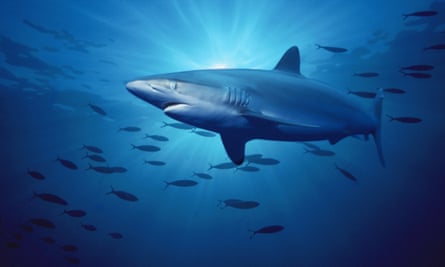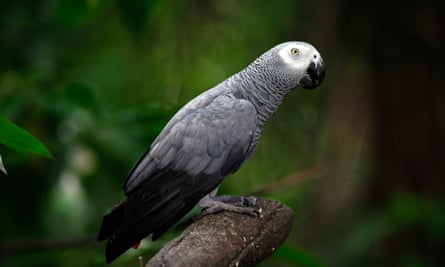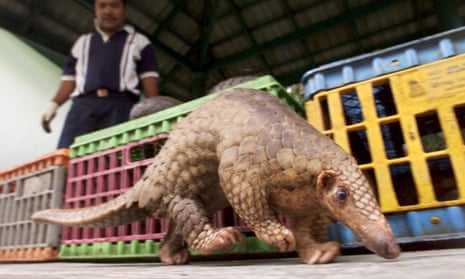A global wildlife summit opening on Saturday is a “do or die” moment for endangered animals around the world, say conservationists, from iconic species such as elephants and lions to lesser known, but equally troubled, creatures such as devil rays and the psychedelic rock gecko.
The summit in Johannesburg brings together 181 nations to crack down on wildlife trafficking, currently a $20bn-a-year criminal enterprise, and to ensure the legal trade in food, skins, pets and traditional remedies does not threaten the survival of species. The member nations of the Convention on the International Trade in Endangered Species (Cites) will vote on proposals to toughen or loosen trade bans and regulations for over 500 species.
A total trade ban is being sought for pangolins, an exotic scaled creature, which is now the world’s most trafficked mammal, while more protection for sharks, parrots and frogs are also on the table. The most controversial proposals are for elephants: some southern African nations want to overturn the ban on selling ivory while a rival proposal from 29 other African countries aims to make protections even tougher.
“With so many of our wild animal and plant species facing serious threats from rapacious poaching and commercial trade, this Cites meeting represents a ‘do or die’ moment,” said Teresa Telecky, wildlife director of the Humane Society International. “Either countries do the right thing and give these imperilled species the highest level of protection possible against unsustainable exploitation, or we risk seeing them die out altogether in the wild.”
The proposals are based on scientific evidence, but national political agendas loom large too. “The stakes are high for so many species and we must make certain that sound science and the precautionary principle are deciding factors and not short-term political or economic interests,” said Azzedine Downes, president of the International Fund for Animal Welfare (IFAW).
Others are concerned that high-profile rows over the elephant proposals, which could all fail to pass, will distract from work on enforcement to end the scourge of poaching. Over 140,000 of Africa’s savannah elephants were killed for their ivory between 2007 and 2014, wiping out almost a third of their population. Elephants are still being killed every 15 minutes on average.
Nations where poaching, trafficking or illegal sales take place should have submitted action plans but Cameroon, Ethiopia, Gabon and Nigeria have not, and could face sanctions on all their wildlife-related trade.
“We are concerned that the summit is likely to be a rerun of the old pattern, with proposals and counter-proposals on legal international ivory trade diverting attention from the real issues,” said WWF in statement. Swaziland has also proposed to legalise the sale of horn from rhino, whose populations have plummeted, but will face fierce opposition.
The species being evaluated for protection at Cites span the land, ocean and skies. African lions ought to get the strongest protection, according to scientists at the Zoological Society of London (ZSL) while Jan Creamer, president of Animal Defenders International, said the big cat’s survival was at stake: “It is clear that we are at risk of being the generation that allowed a magnificent species to disappear from the wild.”
Pangolins, whose scales are sold in China and Vietnam as a supposed medicine, could also get stronger protection. More than a million have been taken from the wild in the past decade, according to WildAid, decimating Asian populations. As a result, poaching has also ramped up in Africa and in June over 11 tonnes of pangolin scales were seized in Hong Kong in just two shipments from Africa. “We could very soon see this amazing species disappear, if the unsustainable trade continues,” says Mark Hofberg, IFAW’s pangolin expert.

In the seas, stricter protection is on the table for silky and thresher sharks, both heavily hit by the fin trade, and for devil rays, whose gills are sold in China. “Devil rays grow very slowly and produce just one pup about every two years, making them intrinsically susceptible to overfishing,” said Sebastián Pardo, at Simon Fraser University in Canada.
The nautilus could also get its first trade protections, as it is being overfished for its beautiful shells which are used for jewellery and ornaments. Many turtle species are eaten in Asia and have suffered heavily as a result, and flapshell and softshell turtle proposals will be voted on during the two-week summit.
In the air, African grey parrots, which are extraordinary vocal mimics, may get the highest level of protection. Scientists estimate that two to three million African greys were captured from the wild between 1975 and 2013, and despite successful captive breeding, populations have decreased by between 50% and 90% and in some places they are locally extinct.
There are many proposals for better protection for reptiles and amphibians. “A lot of lizards and frogs are traded illegally,” said John Scanlon, secretary general of Cites. “They are being taken primarily for the illegal pet trade, and primarily to Europe. We need to get this under control, as these animals are also a critical part of the ecosystem.”
The psychedelic rock gecko, found only in Vietnam, is in line for better protection along with others including the Hong Kong warty newt and both the tomato frog and the false tomato frog.
Cites, which began in 1975, is increasingly regulating the timber trade too and could introduce protection for the entire genus of rosewood species. The market for luxury furniture made from the wood has exploded in recent years, with the rosewood trade soaring by 65 times between 2005 and 2014, and is now worth over $2bn a year.
Some species are already protected, but remain prone to illegal logging. With Asian rosewood numbers crashing, the focus of loggers has increasingly moved to Africa and central America, where they “capitalise on unstable situations in fragile states, moving swiftly from country to country creating devastating ‘boom-and-bust cycles’,” according the Forest Trends group.
A minority of the Cites proposals are to loosen restrictions on the international trade in species that have recovered from previously precarious positions. The total bans protecting the peregrine falcon and the Cape mountain zebra may be lifted.
“The recovery of species like the peregrine falcon shows that Cites can work and that populations can bounce back thanks to trade bans and conservation efforts,” said Ginette Hemley, head of WWF’s delegation to Cites. “If the world takes decisive action in Johannesburg, we can look forward to more success stories in the future.”
Scanlon said: “We have made significant progress since the last Cites summit in 2013, politically, financially and technically. More governments are taking action and increasing the penalties for wildlife crime, which can be seen as low-risk for criminal and terrorist groups.
“This is not purely about wildlife, it’s also about the impact on local people and communities, security and on national economies,” he said. “We haven’t got there yet but, if we persist, we will win.”






Comments (…)
Sign in or create your Guardian account to join the discussion